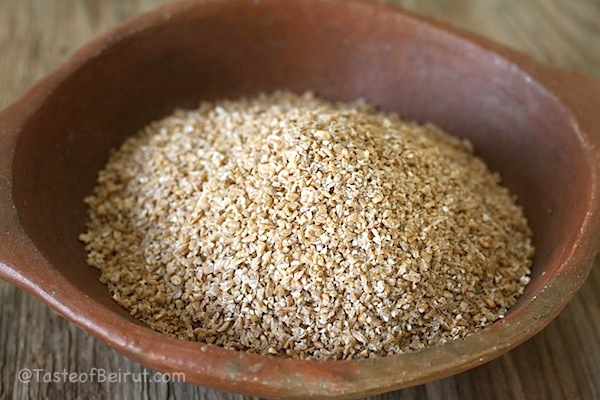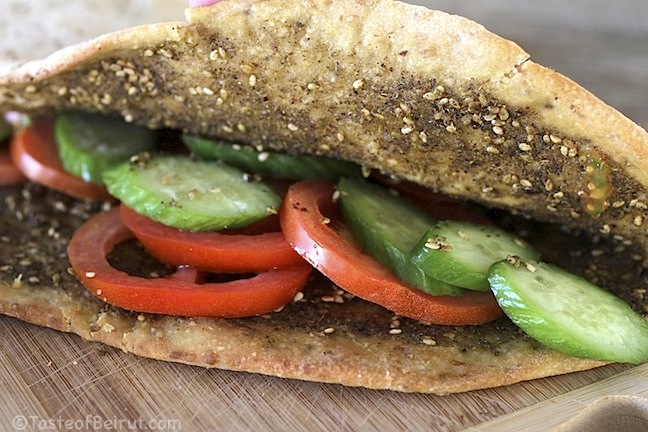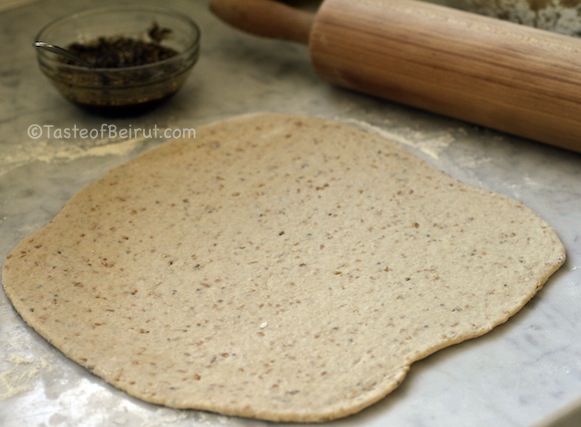Zaatar flatbread with Jreesh
December 16, 2013 • Category: Main Dish

Jreesh is cracked wheat. Let’s not confuse cracked wheat and bulgur; bulgur is parboiled and cracked wheat is just cracked. Both are wheat. They look similar. A popular ingredient in baking and cooking in the South of the country. In Beirut, some bakeries specialize in this type of man’ooshe or flatbread, called jreesh.
Jreesh can be dark or yellow, just like bulgur. It depends on the type of wheat, (I think). It is consumed in pockets throughout the Middle-East and Turkey; in Iraq, for example, it is incorporated in kibbeh dough. In Anatolia (Turkey), it is cooked like rice, in a simple pilaf.
 Jreesh gives bread more flavor. One baker from Kfar Remman, a village in the South reputed for its fine cooks, made us a zaatar and jreesh flatbread (man’ooshe) with a touch of anise in a whole wheat dough. The anise subtly infused it with its sweet fragrance. It was the best. I decided to reproduce it at home.
Jreesh gives bread more flavor. One baker from Kfar Remman, a village in the South reputed for its fine cooks, made us a zaatar and jreesh flatbread (man’ooshe) with a touch of anise in a whole wheat dough. The anise subtly infused it with its sweet fragrance. It was the best. I decided to reproduce it at home.
INGREDIENTS: 4 to 6 flatbreads
- 2 cups whole-wheat flour
- 1 cup white unbleached flour
- 1 tsp salt
- 3 tablespoons oil
- 1/2 cup cracked wheat (jreesh)
- 1 tablespoon anise seeds or 1 tsp anise powder (optional)
- 1/2 teaspoon mahlab (optional)
- 1 (up to 2) teaspoons instant dry yeast
- 1 teaspoon sugar
- 1 cup (or more) water
1. Place the jreesh in a small bowl and cover it with about 1 cup of very hot water; set it aside for 20 minutes. Meanwhile, proof the yeast in a bowl of 1/2 cup of warm water, stirring it with the sugar. Set it aside in a cupboard and wait for it to bubble up, about 15 minutes. Sprinkle the anise seeds in 1/2 cup of very hot water for about 20 minutes.
2. Mix the two flours and salt, adding mahlab if you like. Add the oil and keep stirring for one minute. Squeeze the water out of the jreesh by transferring it to a sieve. Press on it to drain it well and add it to the flour mixture. Stir and add the yeast mixture, then the anise seeds and water mixture. Keep mixing till the dough becomes one mass and does not stick to the bowl. If needed, add more water or flour if the mixture is too wet or too dry.
3. Transfer the dough to an oiled bowl, flip it around to oil it and cover it with plastic wrap; let it rise for a couple of hours. Leave it in the fridge overnight if you are not going to use it right away. When ready to use, preheat the oven to 450F-500F. Flour the counter, divide the dough into 3 or 4 balls and roll each one on a piece of greased foil or parchment paper. Make sure you have a baking sheet in the oven getting hot while the oven is heating. After rolling out the dough into a circle, slather it with zaatar paste all over. Slide the bread onto the hot baking sheet and bake it for about 10 to 15 minutes, until the edges are golden and the bread is puffed-up and cooked through. Serve with fresh sliced tomatoes, cucumbers, and olives if you like. A dollop of labneh is welcome as well.
ZAATAR TOPPING: Mix one cup of zaatar with 1 1/2 cups of extra-virgin olive oil till a paste forms. 
Comments
13 Comments • Comments Feed


Rosa says:
Scrumptious! I love the composition of this flatbread.
Cheers,
Rosa
On December 16, 2013 at 8:02 am
Belinda @zomppa says:
All the delights I can put into this….
On December 16, 2013 at 6:52 pm
Hisham Assaad says:
A MUST TRY. I shall do that too 🙂
On December 17, 2013 at 3:23 pm
Jamie says:
I love flatbreads mostly because they are so versatile. And can be rolled up around food to make a magnificent meal, just like yours. I’ll bet this is so flavorful, the perfect backdrop to such a simple filling.
On December 18, 2013 at 2:51 am
Bahar says:
In Turkey, we use this (I think this is it, jreesh) in a sweet called “aşure”. Actually it’s not used that much in a pilaf (Never eaten it in pilaf form in my life) but more in this sweet dish, I think. I wonder if Lebanese also have a form of aşure :)- it’s made out of beans, jreesh, dried appricots sometimes, chickpeas etc.
On December 18, 2013 at 3:16 pm
Oui, Chef says:
This looks absolutely perfect. I’m quite certain I won’t find jreesh here in the States, could I just substitute bulgar instead, and maybe lessen the soaking time?
On December 18, 2013 at 3:53 pm
Joumana says:
@Oui, chef: I think that jreesh is sold in the US, through whole-grain purveyors and flour distributors. In any case, I tried it with bulgur once and it kind of disappeared into the dough; when I baked it with jreesh, it stays apparent..but it is fun to experiment and I could read about it on your site! 🙂
@Bahar: I was given a recipe for it in a pilaf from a lady who was born in Anatolia, near Mardin; so maybe it is a Kurdish tradition. In regards to açure, yes, there is a tradition here as well, this time of year, and it is made with wheat berries (whole), and flavored with anise and rose water. It is called snaynieh.
https://www.tasteofbeirut.com/2009/11/wheat-berry-pudding/
or hboubieh..lots of similarities in the region; here the influence of the Ottomans is definitely felt 🙂
@Providence: my pleasure! Glad you liked it and were able to use it! 🙂
On December 19, 2013 at 12:35 am
Nadji says:
J’apprends toujours de nouvelles choses en passant chez toi.
Une galette délicieuse.
A bientôt
On December 18, 2013 at 3:55 pm
Providence says:
This recipe is a real blessing ! I’ve made this flatbread tonight, since I bought cracked wheat by mistake and didn’t know what to do with it. I then used the dough for pizza, since I didn’t have zaatar on hand. I didn’t add anise though. I liked both the taste and the texture. This dough is way healthier than the processed white flour dough that we can buy. Thank you !
On December 18, 2013 at 10:25 pm
Providence says:
@ Oui chef : I found cracked wheat at my community food co-op, it was sold in bulk. I believe you can find it in health/organic stores. Bob Red’s Mill sells it as well, ‘cracked wheat hot cereal’. You can find it at amazon.com too. It’s totally worth the effort 😉
On December 19, 2013 at 11:43 am
lilakitchen says:
ça a l’air bien délicieux ^^
On December 19, 2013 at 2:20 pm
Nancy says:
Where do you buy jreesh in the US? Can you share links? When i search all I find is bulgar, sometimes called cracked wheat. Thanks!
On April 13, 2020 at 1:39 pm
joumana says:
@Nancy I am not sure but you can check the online purveyors like safadi or ziyad . Jreesh is actually cracked wheat so you can use that or fine bulgur as a substitute.
On April 13, 2020 at 7:15 pm